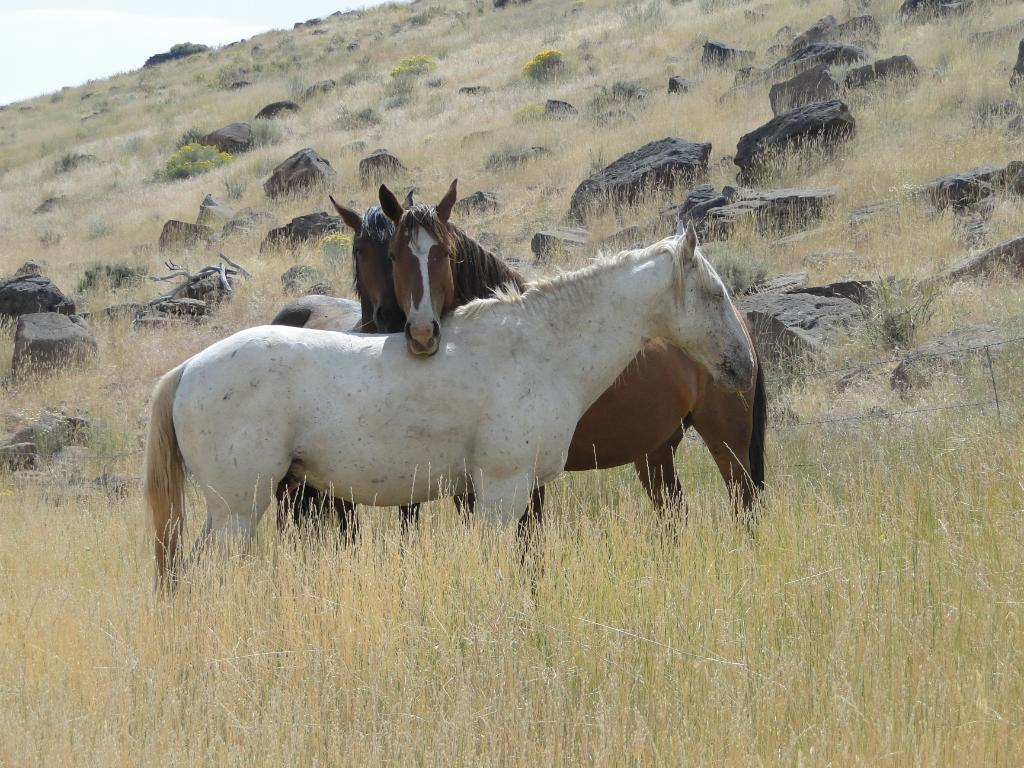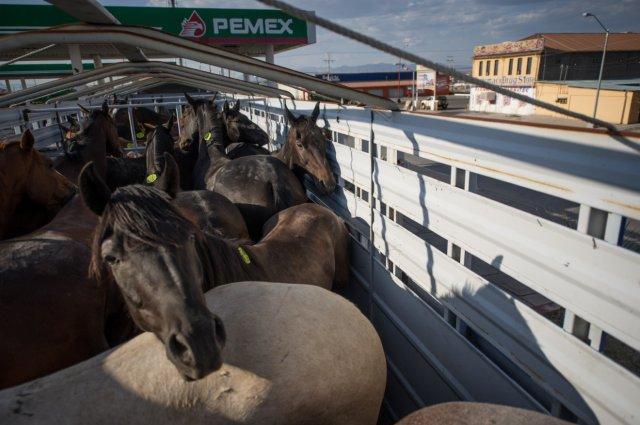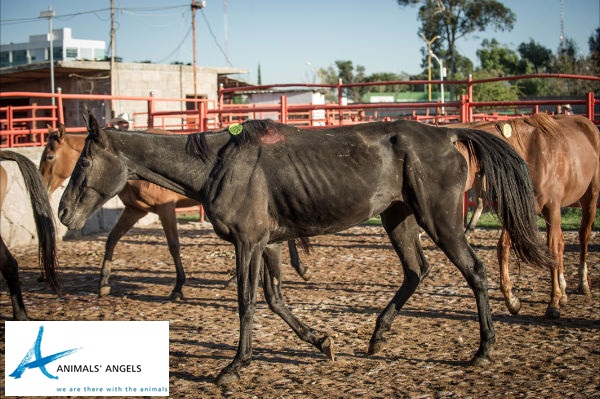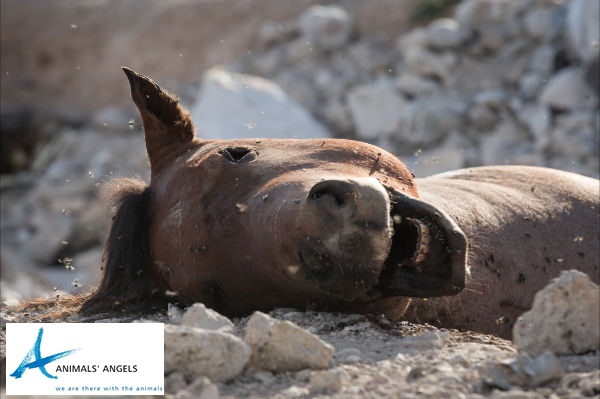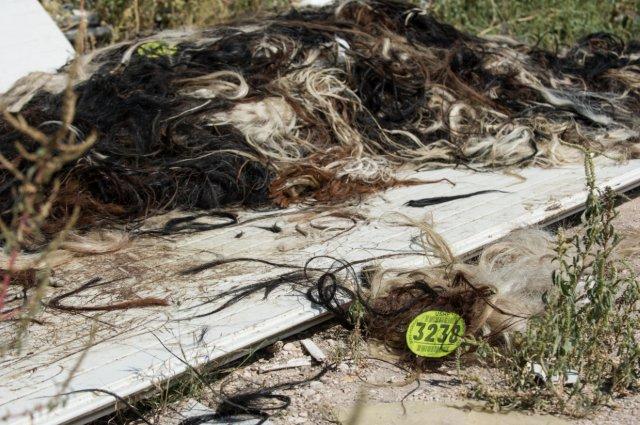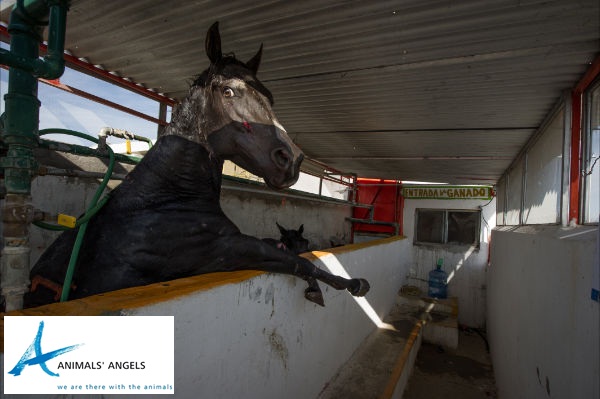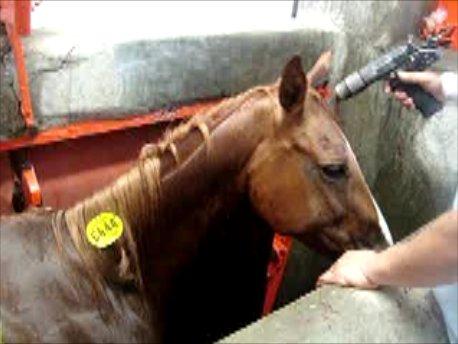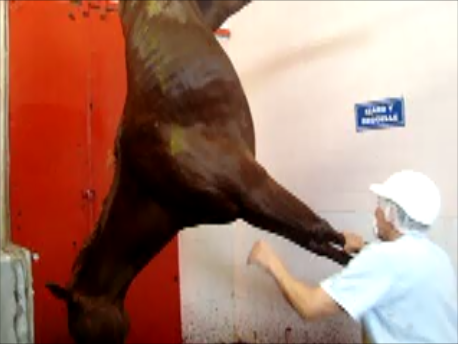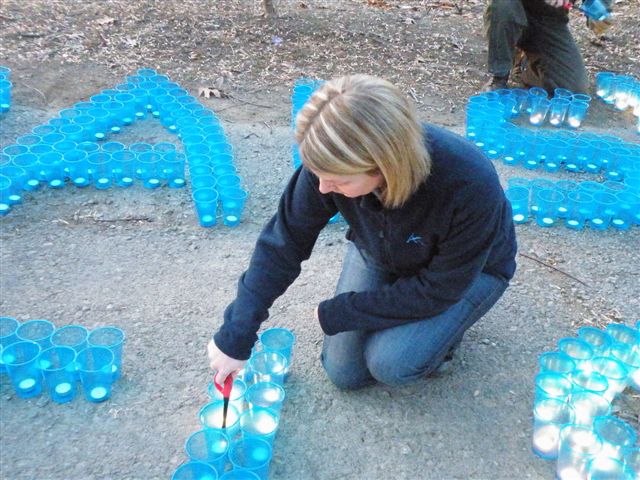Plan to Roundup Wild Horses with Choppers has NM Advocates Crying Foul « Straight from the Horse's Heart
“There aren’t appropriate alternatives in the plan…”
A federal agency’s proposal to use helicopters to gather hundreds of wild horses in northwestern New Mexico has mustang advocates up in arms.
An estimated 405 mustangs now roam the 76,000-acre Jicarilla Wild Horse Territory of Carson National Forest and 32,000 acres of BLM-controlled land in the Carracas Mesa Wild Horse Herd Area.
Range managers say the herd should be much smaller, 50 to 105 horses, because there’s not enough forage to keep the horses healthy, along with the elk, deer and three dozen cattle that share the area.
The BLM has issued a preliminary environmental plan for gathering the Jicarilla wild horses in January and February. The public has until Tuesday, Nov. 21, to comment on the proposal. The agency received more than 2,500 comments before drafting the plan.
The BLM’s preferred option includes using helicopters, which the agency has used for decades to gather mustangs around the West, despite protests from wild horse advocates.
The last few years, the Carson National Forest has rounded up the horses by baiting them with hay and trapping them in hidden corrals, a method the BLM claims hasn’t been effective in removing enough of the equines from the range.
Wild horse advocates say helicopters frighten the horses and injure more of them during a gather than no-chase methods like bait-and-trap. Plus, they say, there are other choices the BLM could use to reduce the herd size, keep it small and reduce the number of mustangs that end up in costly, long-term holding facilities. Restoring the number of mountain lions — the mustangs’ natural predator — is one. Regularly using and tracking contraception is another.
Dave Evans, district manager for BLM’s Farmington and Taos field offices, said all options are on the table for gathering the mustangs, including helicopters. “Helicopters is just one of the options we’re considering for a big gather,” he said. “We thought a more aggressive tactic could address this problem quickly.”
He added that the BLM intends to administer birth control to most of the mares rounded up, but keep fewer than 100 for adoption. The others will be returned to the range. There simply aren’t enough places to send the rest.
Mustang gathers
The Jicarilla and Carracas wild horse areas are home to rugged mesas and red sandstone canyons. They are also dotted with thousands of oil and natural gas wells, and in the fall, hunters comb the region for elk and deer.
The Carson National Forest’s Jicarilla Ranger District has handled the mustang gathers in the Jicarilla since 1977 because the horses stayed primarily on forest lands. The Forest Service relied on helicopters until 1997, when three horses died during a roundup. Mustang advocates cried foul, contending the roundups harmed the horses and the Forest Service didn’t need to remove so many.
From 1999 to 2004, no wild horses were gathered in the area while the Forest Service analyzed the range and came up with a management plan. In that time, the wild horse herds doubled from 93 to 197 animals, according to Forest Service reports.
The agency’s plan calls for limiting the horses to between 50 and 105 in the Jicarilla territory. Currently, there are an estimated 400 mustangs.
Anthony Madrid, who managed the wild horse program for the Carson National Forest from 2005 until last year and is now the Jicarilla district manager, said the agency agreed with horse advocates to change its roundups, including using helicopters only as a last resort.
Madrid worked with wild horse advocates on using bait-and-trap methods and an equine contraceptive called PZP with the Jicarilla wild horse herds and the Jarita Mesa herd in the El Rito Ranger District.
Gentler methods
The agency has hired Dan Elkins, a contractor out of Grants, for the last five years to handle the bait-and-trap gathers. He works with Karen Herman of Sky Mountain Wild Horse Sanctuary to give contraception to select mares before releasing them. Elkins developed a sophisticated method of coaxing the horses into hidden corrals with food or water and using remotely controlled gates to quietly contain them. He’s gathered 84 mustangs on Jarita Mesa this year alone with no injuries to the animals and helped reduce that horse herd close to the size the Forest Service considers optimal, said El Rito Ranger District supervisor Diana Trujillo.
In 2009, Elkins gathered 125 mustangs off the Jicarilla and another 73 in 2010, but that wasn’t enough to keep up with the number of foals born, and the herds continued to grow.
“Dan has done a great job for us,” said Madrid. “But I would say we have not been able to gather enough horses.”
Mitigating factors make the gathers slower in the Jicarilla than in Jarita Mesa. During hunting season, the Jicarilla horses are more skittish and moving constantly. The territory is larger. And it takes more time to round up the horses using Elkins’ methods.
“Now the population is so high, and gentle methods are not working to keep herd levels under control,” the BLM’s Donna Hummel said.
Helicopters may be the most effective way to quickly bring the population under control, she said. Madrid agrees that in the short run, it may be the best answer.
But longtime mustang advocates like O’Dowd say Elkins’ methods combined with contraception are better, cheaper options to managing the herds than what the BLM has continued to do — round up horses with helicopters, adopt some of them out and put the rest on pastures where the agency has to continue caring for them. Currently, 30,000 wild horses are in BLM facilities.
A crossroads
The Carson National Forest and the BLM are at a crucial junction. The BLM is running out of room for the mustangs that aren’t adopted and recently put out a request for ranchers or other property owners interested in establishing horse sanctuaries.
Madrid said the BLM isn’t accepting horses from the Forest Service now because space is limited. He had been sending most of the horses to a prison program in Cañon City, Colo., where prisoners trained the mustangs before they were adopted out. That program also is full. And the number of mustang adopters has declined in the last couple of years due to the bad economy and the high cost of feed, he said.
“We’re really aiming to find a balance that is a sustainable herd,” Madrid said. “I think the bait-and-trap with contraception will work [in the long term].”
Click (HERE) to add much needed Comment at The New Mexican
_____________________________
Hunting Club Shows Disdain
for Native Wild Equines

SCI has a “thing” against wild horses and burros
The case focused on the Twin Peaks Horse Management Area (HMA), located on the northern border of California and Nevada. The BLM conducted the gather during August and September 2010, after SCI joined the BLM in defeating the horse groups’ emergency request to halt the gather.
Before the gather, the horse and burro populations on the Twin Peaks Horse Management Area (HMA) were approximately four times higher than scientifically established appropriate management levels. The excess horses and burros were damaging the ecosystem and harming resident wildlife, including game mammals and birds.
Without management action to lower the horse numbers, these detrimental ecosystem impacts would only escalate. The overpopulation problems at the Twin Peaks HMA are symptomatic of conditions on public lands throughout the American West. SCI and other conservation advocates are working on strategies and regulatory policies to rationally address the problems.
“For the third time in a wild horse case, SCI has represented the interests of hunters in this thorny issue,” said John Whipple, President of Safari Club International. “The BLM must take action when horses threaten to seriously degrade the range and harm other wildlife, including game animals and birds. As ardent hunter-conservationists, we cannot allow horse zealots to use the courts to foist their single-minded agenda on land managers in the West.”
“We are extremely pleased that the court has upheld BLM’s ability in the Twin Peaks Herd Management Area to responsibly manage horse populations based on sound science. Responsible herd management is a vital component to the health and sustainability of our land and wildlife habitat for the future,” stated Gene Schmidt, President, National Association of Conservation Districts.
“As it has done in other wild horse cases, SCI intervened as a party to defend the gather and subsequent relocation of the excess horses and burros to long-term holding facilities. SCI would like to thank all of our coalition colleagues who advocate for ecosystem wide conservation goals on public lands,” concluded Whipple.w horse zealots to use the courts to foist their single-minded agenda on land managers in the West.”
In ruling against the plaintiffs, the Court heavily relied on an argument made solely by SCI to reject one of the horse groups’ primary legal claims. SCI’s briefs and arguments at the hearing on the case enhanced the excellent defense offered by the BLM and its attorneys. The plaintiffs now have 60 days to decide whether to appeal their loss to theNinth Circuit.
Contact: Nelson Freeman
Nelson Freeman
Safari Club International – D.C.
501 2nd St, NE
Washington, DC 20002
Office: 202-543-8733
 Distributed to you by - AmmoLand.com – The Shooting Sports News source.
Distributed to you by - AmmoLand.com – The Shooting Sports News source.
Click (HERE) to Comment and view video
BLM’s Destruction of California’s Last Wild Horse Herd Delayed, for Now

Twin Peak’s “Magic” ~ photo by Grandma Gregg
BLM, Eagle Lake announced today (Nov 20) that the proposal to remove 600 wild horses plus burros from the Twin Peaks HERD Management Area has been temporarily cancelled!
Per Eagle Lake BLM, “There will be no imminent roundup operation in the Twin Peaks Herd Management Area (HMA). The situation will be re-evaluated this January … ESR plan is still under review. ”
The Eagle Lake field office recently claimed they did an aerial inventory that proved there are currently 950 horses on the entire HMA. Recent INDEPENDENT aerial and ground surveys have been done on the Twin Peaks HMA which scientifically proves that the total estimated Wild Horse population is currently within the range of 312 to 387.
Independent assessments of the health of the land and the health of the horses and burros agree with the aerial total HMA population estimate of less than 400 horses plus photos show the health of the surviving horses to be physically robust and forage and water plentiful to get the horses through the next year without undue physical stress if they are left alone.
Many thanks from the wild horses and burros and from all of us who love them to ALL of you who worked so hard to let the BLM know that our Twin Peaks Wild Horses and Burros are very special.
Could THIS be why the Feds have Declared War on Wild Horses and Burros?

Colorado’s West Douglas herd ~ photo by Toni Moore
DENVER— The Bureau of Land Management today proposed allowing oil shale and tar sands development across more 806,000 acres of public lands in Colorado, Utah and Wyoming. The plan stems from a settlement of litigation brought by environmental groups in 2009 that challenged a 2008 Bush plan to open 2 million acres of public land to oil shale and tar sands development. Today’s proposal was spelled out in an environmental impact statement and proposed amendments to 10 land-management plans.
“Oil shale and tar sands development would be ruinous for the Colorado River basin and for the struggle to curb the greenhouse emissions that are causing climate change,” said Taylor McKinnon, public lands campaigns director with the Center for Biological Diversity. “The BLM should have chosen a plan that avoided those impacts by simply prohibiting those forms of development on public lands.”
Today’s plan allocates more than 676,000 acres of land to oil shale development and more than 129,000 acres to tar sands. It subjects development to ecological and economic constraints not included in the Bush administration’s plan. While it reduces developable acres from the Bush administration’s 2008 plan, it increases allocations from what was proposed in a 2012 draft environmental impact statement. Acres allocated for oil shale development have increased by 46 percent since the draft plan; acres for tar sands increased by 42 percent.
“In the face of global warming, a drying West and Frankenstorms like Hurricane Sandy, devoting public lands to dirty, high-carbon development is very destructive public policy,” said McKinnon. “Today’s plan isn’t as bad as the Bush administration’s, but it makes clear that the Department of the Interior is still listening to the fossil fuel industry and its politicians more than climate scientists.”
Producing oil from shale or tar sands can be dirtier than coal given the energy required to extract the oil. The production of every barrel of shale oil sends 50 percent more CO2 into the atmosphere than the production of one barrel of crude oil. Because mining would deplete and pollute water resources and result in large areas of land being cleared and destroyed, commercial development would likely affect Gunnison’s sage grouse and four endangered fish species in the Colorado River — Colorado pikeminnow, razorback sucker, humpback chub and bonytail chub. Oil shale and tar sands mining and processing will also increase regional air pollution.
The Center for Biological Diversity is dedicated to ensuring that atmospheric carbon dioxide pollutant levels are reduced to below 350 ppm, which leading climate scientists warn is necessary to prevent devastating climate change. Further development of greenhouse gas-intensive energy sources, including oil shale, tar sands, and coal-fired power plants, is fundamentally incompatible with achieving this goal. If greenhouse gas emissions are not immediately reduced, the atmospheric carbon dioxide level will rise to approximately 500 ppm by mid-century, triggering mass wildlife extinctions, catastrophic global weather and ecosystem changes, and tragic human suffering.
The Center for Biological Diversity is a national, nonprofit conservation organization with more than 450,000 members and online activists dedicated to the protection of endangered species and wild places.
____________________________________
All but 36 of Davis’ 1,777 purchases coincide with Salazar’s tenure as DOI Secretary

Scott Coffina, a former White House ethics adviser, said any Salazar (above) involvement with the federal sale of wild horses would raise a red flag for investigators
WASHINGTON — Secretary of the Department of the Interior Ken Salazar’s relationship with a Colorado man who worked for his family’s farm and who is under federal investigation for allegedly selling American wild horses to Mexican slaughter houses came under scrutiny this week.
Tommy D. Davis, a livestock hauler from La Jara and former independent contractor at the Salazar family farm in nearby Manassa, has been the largest single purchaser of wild horses from the federal government since 2009.
All but 36 of Davis’ 1,777 purchases coincide with Salazar’s tenure as Interior secretary, now in its fourth year.
Scott Coffina, a former White House ethics adviser, said Salazar’s involvement if any with the federal sale of wild horses to Davis would raise a red flag for investigators.
“Did he have knowledge of any sales to Davis at all? … Did the fact that he had a previous relationship with Davis affect the decision? … Did Davis get favorable terms or a better deal?” Coffina said in an interview.
When a government official was asked if Salazar signed off on sales to Davis, the official indicated he had not done so.
“Sale approval is done entirely at the level of the Bureau of Land Management wild-horse program — not the Department of the Interior,” the official wrote. The Bureau of Land Management is part of the Interior department, but the official’s statement suggests that BLM officials had no contact with officials in Secretary Salazar’s office.
Coffina said that unless new information about Salazar’s ties to Davis emerged, federal officials are unlikely to examine their relationship or request that Salazar recuse himself from the the Interior department’s internal investigation of Davis’ sales of the animals.
“The fact that he worked for him — Salazar said it was once or twice — I don’t think there’s any recusal required for that … I don’t see the relationship between Davis and Salazar is close enough in terms of benefit to Davis. It’s not clear how long ago he worked on the farm. Salazar has been in D.C. since 2004,” Coffina said, referring to Salazar’s election as a U.S. Senator.
Blake Androff, a Salazar spokesman, noted that the inspector general of the Interior department launched an investigation of Davis’ sales in June. “The Interior department takes the allegations against Mr. Davis very seriously,” he said, “and we look forward to the results of that inquiry. Anybody that is found to have violated the law should be held accountable.”
Davis did not respond to a voice mail left at his home. He told the online publication Pro Publica that “has done quite a bit of trucking” for Salazar, while Salazar’s brother LeRoy told The Observer last week that Davis worked as an independent contractor for the Salazar family farm once or twice.
Salazar said through a department spokesman he has “no recollection of Tom Davis and to his knowledge, has never had any business dealings with him.”
Although Salazar has not said he knew Davis, his relationship if any with his neighbor could emerge as a flashpoint for federal investigators. Coffina said if investigators present evidence that Davis sold the wild horses to slaughter houses, Salazar may need to recuse himself.
Click (HERE) to Visit the Observer and to stir up the Conversation
 “Hello, I must be going,” was one of Groucho Marx’s most notable lines—and perhaps a fitting coda to the Cabinet careers of several top Obama officials, expected to leave after his first term is complete.
“Hello, I must be going,” was one of Groucho Marx’s most notable lines—and perhaps a fitting coda to the Cabinet careers of several top Obama officials, expected to leave after his first term is complete.